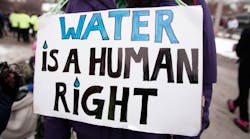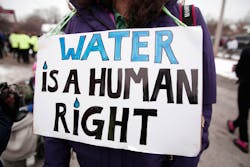In January 2016, I posted about the widely publicized case of drinking-water contamination in Flint, Mich., an incident recently featured on public television’s NOVA series. A researcher from Virginia Tech, along with some of his students, discovered that, to save money, the state had stopped purchasing Flint’s water from Detroit, where it came from Lake Huron, and instead began taking it from the Flint River. Sadly, U.S. Environmental Protection Agency (EPA) water experts had known for months the water was unsafe to drink before any action was taken. In some cases, the lead levels exceeded federal drinking-water standards by thousands of parts per billion and, as a result, many children suffered from lead poisoning.
As if that were not shameful enough, we now learn that more than 8,000 Flint residents, many of whom have been drinking bottled water provided by the National Guard, have been threatened with termination of their water service for failure to pay their water bills. And in Detroit, more than 50,000 households over the last three years have had their water service shut off because they couldn’t pay their water bills. This problem is not limited to economically depressed communities in Michigan. Residents in rural Mississippi, Louisiana, Alabama, Kentucky, and Arkansas are at high risk of finding their water to be unaffordable. In fact, 75 percent of Mississippi residents are at risk, while 81 percent of urban areas in the United States are at high risk. All told, it is estimated that, by 2022, one-third of American households—some 41 million of them—may be unable to pay their water bills.
According to research presented by Elizabeth Mack and Sarah Wrase of Michigan State University, water prices will have to increase 41 percent over the next five years just to cover repair and replacement of aging water-infrastructure systems (much water distribution piping was installed post-World War II, and federal funding for these systems has fallen from more than 60 percent in the late 1970s to a mere 9 percent now) and climate-change adaptation. Engineers estimate the minimum cost of bringing these water systems up to code to be $1 trillion over the next 25 years, with an additional $14 billion to $26 billion for climate-change adaptation over the next 30-plus years.
Many places in colder climes have laws that prevent electric utilities from terminating service for non-payment during winter; unfortunately, the same apparently is not true for water utilities, which can terminate water service whenever their customers fail to pay their bills. The EPA recommends water and sewer charges not exceed 4.5 percent of household income; yet for a family of four in Atlanta with a household income of $32,000, the average water bill is nearly $4,000, or more than 12 percent of their income.
In their paper, Mack and Wrase suggest restructuring water rates based on income. However, they also point out some type of subsidy—perhaps similar to a food-stamp program—would be required to protect poorer households.
We regularly read about the lack of access to fresh water abroad and yet hear very little about the water crisis in our own country. This is an issue of which we all need to be aware.










